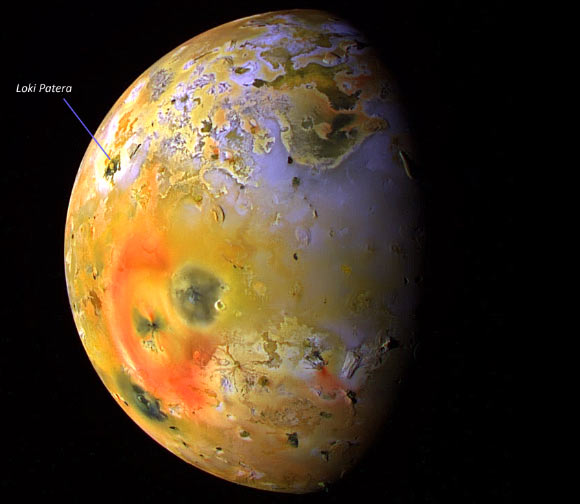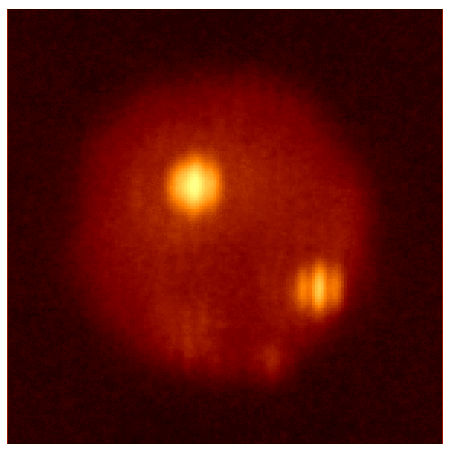
Taking advantage of a rare orbital alignment between two of Jupiter’s moons, Io and Europa, researchers have been able to make an exceptionally detailed map of the largest lava lake on Io. The lake is called Loki Patera. On March 8, 2015, Europa passed in front of Io, gradually blocking out Io’s light. The event enabled researchers to isolate the heat emanating from Io’s active volcanoes. The infrared (heat) data showed that the surface temperature of the lava lake Loke Patera steadily increased from one end to the other, suggesting that the lava had overturned in two waves that each swept from west to east at about 3,300 feet (about a kilometer) per day.
Loki Patera is the most active volcanic site on Io, which is known to be our solar system’s most active volcanic world. The lake is about 127 miles (200 km) across. Overturning lava is a popular explanation for the periodic brightening and dimming of Loki Patera, which is named for a Norse god (a patera is a bowl-shaped volcanic crater). The hot region of the patera is larger than Lake Ontario, one of the five Great Lakes of North America.
Astronomers first noticed Io’s changing brightness in the 1970s, but it took two early spacecraft – Voyager 1 and 2 in 1979 – to learn that the brightness changes were due to volcanic eruptions on Io’s surface. Despite highly detailed images from NASA’s Galileo mission in the late 1990s and early 2000s, astronomers continue to debate whether the brightenings at Loki Patera – which occur every 400 to 600 days – are due to overturning lava in a massive lava lake, or periodic eruptions that spread lava flows over a large area on Io.
Katherine de Kleer is a University of California Berkeley graduate student and lead author of the new study about waves on Loki Patera. The study is published in the May 11, 2017 peer-reviewed journal Nature. De Kleer said:
If Loki Patera is a sea of lava, it encompasses an area more than a million times that of a typical lava lake on Earth. In this scenario, portions of cool crust sink, exposing the incandescent magma underneath and causing a brightening in the infrared.
Co-author Ashley Davies of the Jet Propulsion Laboratory in Pasadena has studied Io’s volcanoes for many years. He said:
This is the first useful map of the entire patera. It shows not one but two resurfacing waves sweeping around the patera. This is much more complex than what was previously thought.

Europa’s surface is coated in water ice, and so it reflects very little sunlight at infrared (heat) wavelengths. That why the 2015 occultation of Io by Europa let researchers pinpoint the infrared energy coming from Loki Patera. During the occultation, the researchers obtained images with the twin 8.4-meter (27.6-foot) mirrors of the Large Binocular Telescope Observatory (LBTO) in the mountains of southeastern Arizona. Europa took about 10 seconds to cover Loki Patera completely. Co-author Michael Skrutskie, of the University of Virginia, who led the development of the infrared camera used for this study, said:
There was so much infrared light available that we could slice the observations into one-eighth-second intervals during which the edge of Europa advanced only a few kilometers across Io’s surface. Loki was covered from one direction but revealed from another, just the arrangement needed to make a real map of the distribution of warm surface within the patera.
These observations gave the astronomers a two-dimensional thermal map of Loki Patera with a resolution better than 6.25 miles (10 km). The temperature map revealed a smooth temperature variation across the surface of the lake, from about 270 Kelvin at the western end, where the overturning appeared to have started, to 330 Kelvin at the southeastern end, where the overturned lava was freshest and hottest.
In the video below, lower panels show the intensity of Loki Patera as a function of time as it is covered (ingress) and uncovered (egress) by Europa. The red curve is the model light curve corresponding to the intensity map shown above, the best-fit map to the observations. The animation shows Europa sweeping across the patera and obscuring different portions of its floor.
Using information on the temperature and cooling rate of magma derived from studies of volcanoes on Earth, de Kleer was able to calculate how recently new magma had been exposed at the surface. The results — between 180 and 230 days before the observations at the western end and 75 days before at the eastern — agree with earlier data on the speed and timing of the overturn.
Interestingly, the overturning started at different times on two sides of a cool island in the center of the lake that has been there ever since Voyager photographed it in 1979. De Kleer said:
The velocity of overturn is also different on the two sides of the island, which may have something to do with the composition of the magma or the amount of dissolved gas in bubbles in the magma. There must be differences in the magma supply to the two halves of the patera, and whatever is triggering the start of overturn manages to trigger both halves at nearly the same time but not exactly. These results give us a glimpse into the complex plumbing system under Loki Patera.
Read more via UC Berkeley, and check out the video below. It shows a schematic simulation of two resurfacing waves sweeping around Loki Patera at different rates and converging in the southeast corner.
Bottom line: New data on the massive molten lake on Jupiter’s moon Io – most volcanically active world in our solar system – suggest 2 lava waves per day, slowly sweeping west to east.











